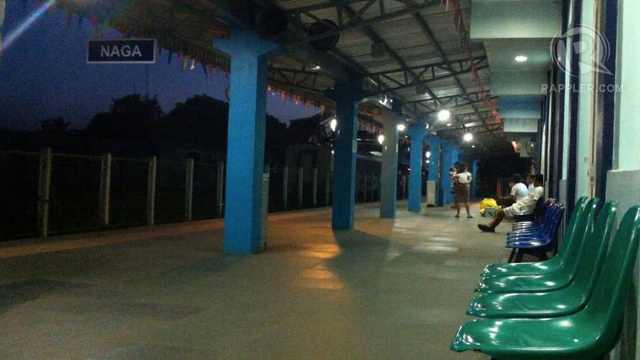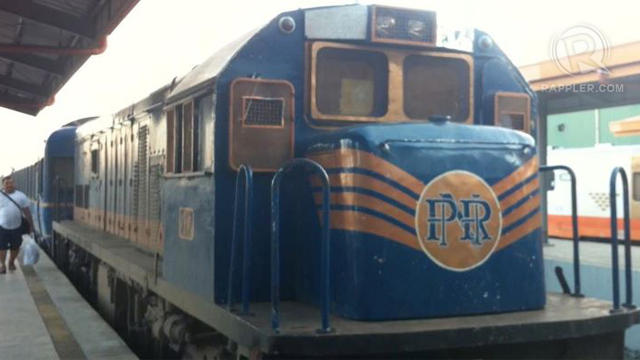SUMMARY
This is AI generated summarization, which may have errors. For context, always refer to the full article.
NAGA CITY, Philippines – The Bicol Express is back.
After years of absence, the legendary railway line is once again operating the Tutuban-Naga route, its refurbished train cars speeding their way through the tracks every night since a quiet re-relaunch September this year.
The launch came after several months of test runs by the Philippine National Railways, even as the initial run which started in July was cut short by damage to the rails due to typhoons. The new Bicol Express resumed service in September just in time for the Peñafrancia Festival.
The line’s revival has sparked interest in rail travel and among tourists and rail enthusiasts alike. But for Bicolanos, the reawakening of the once-silent tracks means so much more than an additional means of travel between the capital and their hometowns.
The Bicol region owes a lot to trains, says Victor Dennis Nierva, a poet, railway enthusiast, and professor at the Ateneo de Naga University. It would not be the Bicol it is now were it not for the industry.
Nierva says the history of the Bicol Express goes all the way back to the establishment by the Americans of the railway line from Manila to Legazpi in the 1920s. It followed the Manila-Dagupan line, which was established decades earlier, starting operations in 1892.
“The early Bicol Express…was a beautiful train,” he recounts. “[It had] powerful engines; very long train sets—20 to 17 cars at most. It had several classes—a sleeper aircon, reclining aircon, and an economy class; freight cars; and dining cars.”
Enrique Guevara, a passenger in his 70s who rode the line just before All Souls Day, remembers it fondly. “Since 1953, ’54, nagsasakay na ako sa locomotive,” he says as he awaits the departure of the train from Naga City. “Kaidto, ang tren talagang siksikan na marhay (Back then, the train was really packed),” he says. “Ma pa man nin bus pa-Manila kaidto. Siksikan talaga (There were no buses going to Manila yet. The trains were really full).” He usually rode the economy class car at the time, with a fare of only P9.50 (now it’s from P500 to P1,000).

The Mayon Limited, a faster, more modern rail line, was later introduced, but the name of the older line, Bicol Express, stuck. It eventually became part of the region’s identity, the historian Nierva says. “It even became a dish,” he adds, referring to the spicy fare made popular by local cooks.
Economic lifeline
Nierva says that in its heyday, the Bicol Express was the main mode of transportation for Bicol, an economic lifeline for the region before the age of trucks, buses, ferries, and planes.
“It came before land transport. Mas nauna iyong riles kaysa bus. In fact, napakaprogresibo ng daangbakal noong mga panahong iyon dahil wala siyang kalaban,” he recounts. (Trains came ahead of the bus. Rails were so progressive then because they did not have competition.)
The trains—dozens of cars long—started their journey from Manila’s grand Tutuban and Paco stations, and barreled their way through southern Luzon, passing by towns and cities of all sizes.
Railway stations along the route also doubled as marketplaces, as goods from the capital and from other provinces were offloaded there. In return, the town’s products leave when the train again passes by on its return northward.
“When the freight train arrives from Manila, when it passes by a station, it leaves two or three wagons,” Nierva says. “Kakargahan iyon ng pangarga—ng copra… asin, for example, or flour from Hondagua, Quezon. And pagbalik noon, dadalhin na niya uli.” (It would be loaded with copra, salt…And when it returns, carry the same again.)
Guevara, on the other hand, says he used to send goods to his relatives in other provinces via the train. “Nagpapadara akong dilis… diretso duman sa bilas ko sa Pampanga. Diretso ang biyahe (I used to send dried fish to my sister-in-law in Pampanga. The train brought it directly to them),” he adds.
It also brought people to the city in their quest for a better life. “Noong una itong tumatakbo, tanda ito ng progreso doon sa dinadaanan niyang mga lugar,” he says. “Train stations gave a sense of security to a place, in terms of economy.”
‘Pagpasok sa tren, nagta-Tagalog na’
It wasn’t just an economic engine for a region battered by typhoons and volcanic eruptions. The train was also a social and cultural fixture.
Nierva explains that the trains were a social leveler of sorts. “Kine-cater niya kasi lahat–from (class) A, B, C, D. Kung may (class) E pa kayang-kaya niya iyan eh. Pati asong nawawala sa mga bayan-bayan, sumasakay sa tren.” (They catered to all…If there was a class E, they could still afford the trains. Even stray dogs in towns rode the train.)
The stations themselves were important hubs of activity. They served as a transport hub, a market, a meeting place, an attraction.
Train masters also played a significant role in the towns. “The train master was an important person in a town… he bid people goodbye when the train left, and he welcomed them when they arrived. Everybody knew the train master, especially in the smaller towns,” he adds.
“You can view railway stations as gateways to towns or districts,” says Nierva. People back then could identify from what station or town a person came from just by knowing their surnames.
It also ferried the culture of two regions: the laid-back, provincial life of Southern Luzon and Bicol, and the hectic, fast-paced life of Metro Manila.
“May biro pa nga noon, ‘pagpasok ng Bicolano sa tren, nagta-Tagalog na,’” he says. “It ferries not just the people, but also the culture of the place.” (There was a joke before. Whenever a Bicolano entered the train, he already spoke Tagalog.)
Losing its luster
And then came the highways and the buses. The trains, which ran on a single track and had specific stations, were no match to the newcomers, who were numerous and could go any route with a road.
The schedule of the trains also worked against their competitiveness: in some towns, especially in Quezon, the trains arrived at inconvenient times (midnight, or very early in the morning); on the other hand, buses could leave and arrive as they pleased.
Trucks, on the other hand, slowly replaced the train as the main method of transporting goods to the region.
Add to the mix the effects of World War II, years of government neglect, and reliance on foreign assistance to maintain the trains and tracks, the Bicol Express–along with the entire railroad system in the country–slowly lost its luster and prestige.
“When the railroad industry declined, many railroad towns died,” he says. “Many of those places are still inaccessible via land transport,” he adds.
The Manila to Bicol train services came to a screeching halt in 2006, when, with railroads battered by Typhoon Milenyo, and aging rolling stock, the PNR decided to stop the service altogether.
Longing for the train’s return
But the tracks were to be awakened once again. And on June 29, 2011, some five years after the last commercial run of the train to the region, and after months of test runs, the tracks came back to life.
With the revival of the line came nostalgia and excitement, especially among those who saw the Bicol Express in better days.
“When the news came to Naga na babalik na, babalik na iyong Bicol Express (that the Bicol Express was returning), everyone was excited. Everyone was asking, ‘Kelan na ba, kelan na ba babalik? (When is it returning)?’ And then when it arrived, finally, everyone was expressing intent to ride,” he recounts.
The service now runs daily between Tutuban and Naga, with one train heading south and one train going north. Both trains leave the terminal at 6:30 pm, on the dot, usually with three cars, all for passengers. The trains arrive at their destinations the following morning.
It is a product of months of delayed test runs, marred by aging facilities and tracks, and P1 billion pumped into the company.
The company has so far received 32 cars donated by the East Japan Railway Co., mainly being used for the line. It expects another 30 cars before the year ends, it adds.
In the near future, the PNR plans to add a dining car, televisions, wifi facilities, and Executive Sleeper cars, as demand goes up. For now, the rail line currently uses only the Family Sleeper and Economy cars. The Family Sleeper has bunk beds, while the the Economy has a 2×2 seating arrangement using reclining seats.
Soon, the PNR says, the line will eventually reach its southernmost terminus, in Legazpi City.
But for now, people must wait before the iconic duo of the Mayon Volcano and the Bicol Express can be photographed side by side, just like how postcards and textbooks pictured them back then.
Nierva observes that most passengers are either tourists who seek to experience riding the line for the first time, or those who rode the train back in the day.
“Noong unang tumakbo (uli) iyong Bicol Express, sabi ng tatay ko, karamihan ng sumasakay iyong mga matatanda. Gusto nilang maranasan uli iyong pagsakay sa tren,” says Nierva, referring to his father, a PNR employee. (When the Bicol Express first became operational again, my father said that majority of those who rode it were old folks. They wanted to experience riding the train again.)

But Nierva sees a deeper root of this excitement and longing for the train’s return—its long and winding history has been inextricably linked to the Bicol Region’s ups and downs for nearly a century.
He notes that Bicol has ordained images. “For example, Mayon, highly romanticized. Sili. Pili. And I think the fourth one is (the) train. And it must be,” he says.
He hopes that the government will be resolute in reviving not just the Bicol Express, but the entire rail industry as well. “I want to be hopeful that this revival will eventually find its smoother period…so that our aspirations as a region, as a people—the entire country, not just Bicol—as well as our culture, our economy, and our daily lives, would benefit from the railway,” he adds. – Rappler.com
For more information on the Bicol Express, go to the official Philippine National Railways page on Facebook at www.facebook.com/pnrailways.
Add a comment
How does this make you feel?
There are no comments yet. Add your comment to start the conversation.